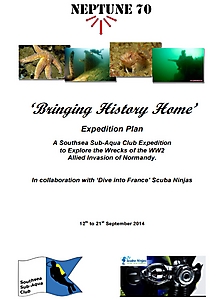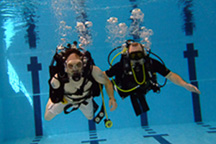Club Diving
Members of Southsea Sub-Aqua Club frequently dive along the South coast of England and have dived much of the rest of the UK and around the globe. The pages linked below provide some useful local information, as well as samples of what our members have done or are doing.
Southern Red Sea Trip - Oct 2017
- Details
- Category: Trip Reports
In October 2017, 6 Club members went to the Southern Red Sea aboard the liveaboard Princess Diana on a trip organised by the folk from Roots Camp. For some, it was their first trip to the Red Sea or on a liveaboard, and while the weather was not always perfect, we all had a great time with some excellent diving in the less visited parts of the Red Sea. Steve Balckburn has compiled an informal diary of the trip, which can be seen here: ![]()
Southsea Sub-Aqua Club divers to help find Veteran's D-Day ship
- Details
- Category: No Roses on a Sailor's Grave
When historian and archaeologist John Henry Phillips made a promise to WWII British Navy veteran Patrick Thomas, he had no idea where the adventure would take them.
From the depths of the National Archives to the murky waters of the D-Day landing beaches, they’ve joined forces with a team of divers from Southsea Sub-Aqua Club, historians and experts as they zero in on Patrick's vanished shipwreck.
Objective: Find the wreck and build a memorial in honour of Patrick's shipmates.
Filming has already begun, but they need your help to complete this incredible untold story and share it with the world.
Like most veterans, Patrick came home from the war and got on with his life. He never spoke of the sinking or his later adventures in the Far East until his twilight years, figuring his story and the story of his ship would die with him. John intends to change that.
PATRICK'S STORY
June 6th 1944: D-Day. Patrick Thomas, a telegraphist in the Royal Navy boards a craft in Portsmouth as thousands of vessels and tens of thousands of soldiers prepare for the day that changed history. His landing craft would be part of the first wave on Sword Beach before heading offshore to cover communications for land battles. At night, the craft would join others in forming a line to defend from E-Boats and Manned Torpedoes. During the day, the crew were either catching up on sleep or taking part in sea rescues.
June 25th 1944: Patrick’s ship was sunk by an acoustic mine. He recalls regaining consciousness whilst already in the water, bleeding from the head and covered in Battleship Grey paint. He watched the ship turn and sink to the bottom of the Baie de Seine. Most of the crew went with it. With men and machines dropping like flies throughout the Second World War, the ship and her men have largely vanished from history.
Patrick and the families of the crew have no place to honour the fallen who sacrificed so much for our freedom. No one knows where those men ended up. There is no memorial to lay a wreath. Seven decades later all that will change.
A PROMISE IS MADE
John Henry Phillips, former touring rock band member turned conflict archaeologist and war historian was on his way to one of many WWII celebration events. By chance this time, his accommodations were mixed up and he found himself without a place to stay. Thankfully, a kind old veteran by the name of Patrick Thomas offered John his spare room.
A wonderful and unique friendship was to bloom over the next few events and years. One day, having visited Sword Beach earlier and looked out at the water, John said to Patrick: "You know, your ship really deserves a memorial." He then went further; "Patrick, someone should find your ship". Needless to say, Patrick was all for it.
The only problem: He has no idea where to begin building a permanent memorial. More importantly, no one knows where the ship is, there are almost no records to help find it, and, oh yes, John can’t scuba dive.
Undeterred and realizing the gravity of his promise and his friend’s age, John begins a search for the missing ship and an adventure to build a permanent memorial to honour his old friend and the crew that was lost.
THE IMPACT
When John told his story they realized the urgency in getting the project done quickly. Like all WWII veterans, Patrick isn't getting any younger. Every year we lose more of these heroes and with them goes vital history that can never be retold. Living memory is what attracted John to modern conflict archaeology and feel a duty to attempt to tell this story while Patrick is still here to witness the discovery of his ship and unveil a memorial.
John's relationship with Patrick is key to the story and their time together is touching to watch in this SHORT VIDEO.
A formal application to conduct an underwater survey has been submitted to the French Authorities. The results will be published here after the completion of the project.
Project Cardonnet - Final Report
- Details
- Category: Project Cardonnet
Our expedition to Normandy to investigate and document wrecks of the Banc de Cardonnet has challenged us in many ways. Our team of divers has been supported throughout by many people and organisations who have helped us achieve our aims and objectives. With diving only possible on 4 days, and further restricted by tides and visibility we have gathered a remarkable amount of information.
This information has helped us to begin to understand these wrecks and their part in the events of D-Day. Two of the wrecks (contacts 468 and 475) are likely to be LCT(6)s though we cannot be sure of their identity. Contact 466 is likely to be the bow of LCT(5) 458 due to the vicinity of her cargo of vehicles at contacts 471 and 470. The other wreck (Contact 464) is unidentified but likely to be a landing craft. We await the outcome of the French Navy bomb disposal team visit to this site.
Project Cardonnet has demonstrated our determination to conduct a responsible, and carefully managed, project, mindful always of the sensitive nature of these sites and that we were ambassadors for British diving by ensuring we met the requirements needed to conduct such a project in French waters. We hope that this report and our project will be viewed as a success and our sincere thanks to all those who have helped us with this remarkable endeavour to understand and honour the loss of those men of the Normandy Campaign.
The full report runs to over 90 pages and is nearly 5Mb, so will take some time to download. If you would like to find out in detail about the conduct and conclusions of the expedition, please download the report here: ![]()
The Mulberry 70 Project Report
- Details
- Category: Mulberry 70
The full report runs to over 70 pages and is around 11Mb, so will take some time to download. If you would like to find out in detail about the conduct and conclusions of the project, please download the report here: ![]()
The Normandy 70 Expedition Report
- Details
- Category: Normandy 70
The SSAC Normandy expedition to dive the D Day wrecks with Catherine Connors and the Scuba Ninjas was a fantastic experience for everyone. Catherine’s hard work in planning is to be commended and her generosity of spirit made everyone feel so welcome. Meeting and diving with people from many nations and sharing our passion for wreck diving soon developed into lasting memories and friendships. In future we hope to build on these relationships and discover new information which will help with the public record of these historic wrecks.
We also discovered that the interest in the Normandy wrecks extends far beyond the diving community and that we can help play a part in improving the knowledge and understanding of the events of June 1944.
Whilst our respective diving Agencies and Authorities may operate under slightly different processes and procedures we showed that our common passion for diving can bring us all together in our appreciation of our underwater world in a way that we can then share with others.
The Club thanks all who took part and gave their time and efforts so freely and to the British Sub-Aqua Club for BEGS Grant which assisted in the cost of ferry transport to Normandy.
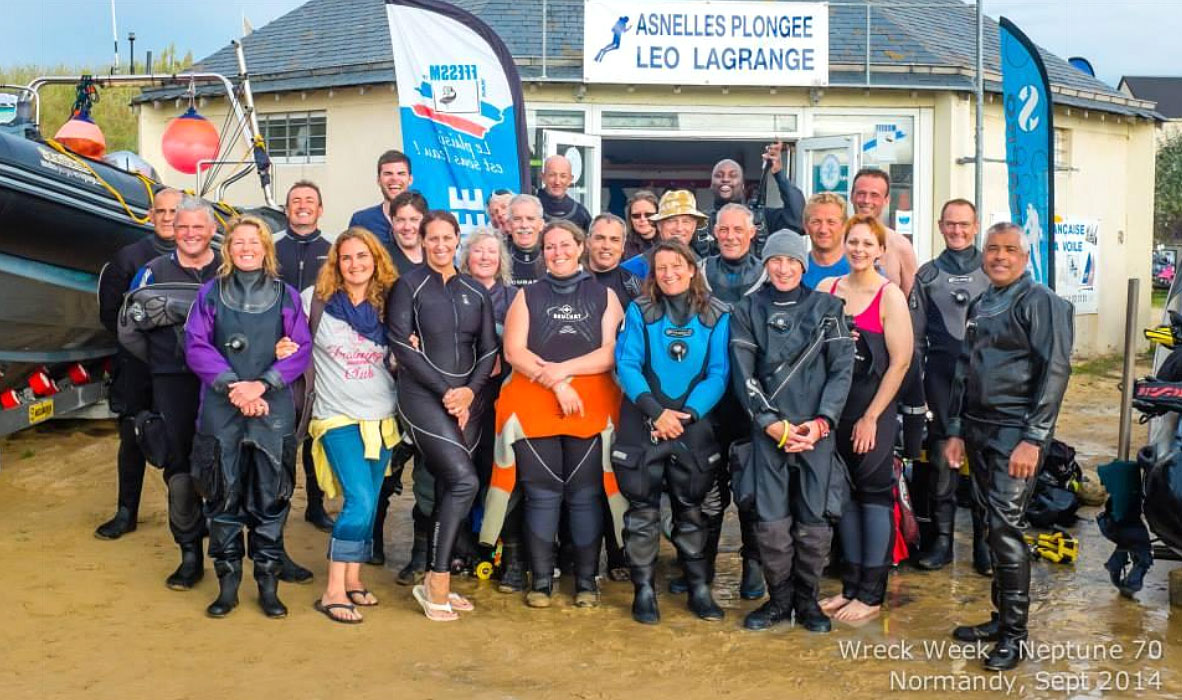
The full report runs to over 50 pages and is nearly 10Mb, so will take some time to download. If you would like to find out in detail about the conduct and conclusions of the expedition, please download the report here: ![]()
Normandy 70 - Wreck Week Expedition Diary
- Details
- Category: Normandy 70
The Normandy 70 Wreck Week took place between 13-21 September 2014. Normandy 70 was an expedition by Southsea Sub-Aqua Club to dive and record wrecks associated with the maritime phase of WW2 Allied invasion of Normandy otherwise known as Operation NEPTUNE. This expedition was inspired by a BSAC Southern Region initiative (NEPTUNE 70) which seeks to encourage branches to investigate and dive wrecks associated with Operation Neptune in British waters.
Expedition Members recorded a daily account of the diving and other activity during the Expedition, and this informal daily diary with pictures, information on the wrecks, diving and other activity can be viewed by clicking the links below: (Owing to the number of pictures, these files may take a few seconds to load in a new window)
Mexico 2015 - The Unofficial Account
- Details
- Category: Trip Reports
In February 2015, 16 members of the Club and some friends jetted off to Mexico to sample the delights of Cozumel and the Yucatan. A comprehensive diary will appear in the Dive Trip section of the website in due course, but meanwhile here is an account of the trip written by Ali Bessel.
Mexico - February 2015 – Ali Bessell
A trip was organised by Dawn Barnard, primarily to dive the Cenotes, but to include a few days diving on the famous Cozumel reefs. I have wanted to dive the cenotes for years, which prompted me to do an Introduction to Cave Diving with Martyn Farr quite a few years ago, just to check out how I felt about overhead environments and how it would feel if all the lights went out and it was a long way back to surface air. Thought a trip to Wales would be cheaper than getting to Mexico and finding out there that it might not go too well. So what I confirmed, is that dark and overhead is fine, but ‘silt out’ is definitely something I really am not happy about, despite that in effect, it’s the same as ‘dark’ in the great scheme of what you do about it. But diving in mine shafts in Wales was accomplished so I had no qualms about the Ceynotes.
We arrived in a lovely hotel in Cozumel, 16 or so people. All the standard stuff, bed, food, pool, beach etc, normal so far, and a pier from which the shuttle boats could pick us up in the morning to get to the dive sites. Dawn, our illustrious overworked leader, is a master of smooth manipulation, with a smiley sweet demeanour, that hides some serious fangs. You will buy those raffle tickets, attend that social event, and blindly support some charity you have no interest in, the money gliding from your wallet/purse to that collection jug/ticket purchase. We had not been in the hotel for one hour and these skills were called on, when a room for two of our party was not available. Despite the confirmation booking email, no room. However, the sweet fang hiding smile, those dulcet tones, could not get the desired result, and no room materialised. Well everyone has an off day! Turns out they regularly overbook, sometimes to the tune of 80 people, and then just shuttle people about the island to the other hotels. And no-one throws a tantrum? ‘Oh well…this is Mexico’, a phrase I heard regularly. So the homeless pair, Phil and Trine, were split, and an extra bed was put up in two others pairs rooms, and the problem was sorted. Easily enough space and no-one really cared. Soon too distracted by iguanas, wild pigs, terrapins, crocodiles, and rich bird life, all in the hotel grounds, to really care about the sagas of beds and bathroom rotas. A few cocktails later…what room?
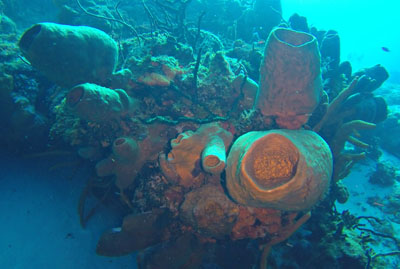
Breakfast, buffet, I had chillies; I’m going to regret that! Pier, small boats arrived, nitrox had been ordered, all of the nitrox ordered did not turn up, and some fills were under 200 bar. Wheel out our illustrious leader! Polite, sweet talking fang bearer wades in again on everyone’s behalf, with some team back up of course. All chilled but point made, promises that it will be rectified in the morning and the day begins. All the dives turn out to be gentle to not so gentle drift dives over lovely sponge rich reefs, with corals, small ascidians and apparently some fish, or ‘clutter’ as I call them. Actually even I looked at some of these fish…..but why when there are all these sponges?
Lunch on each day was spent at another small pier that just ended at the jungle edge. Fruit and cake were provided and we all wandered about on the 50 yards of wooden pier, along with the other 6 boat loads of people. You did not really notice the other boats at the dive sites, but here they all were during the surface interval.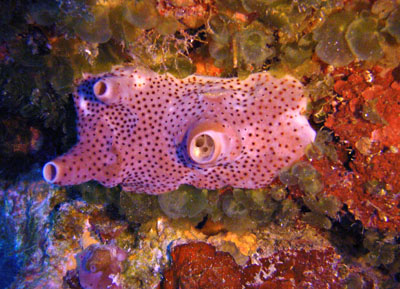
One dive involved an over-interested large green/yellow moray eel, which I was happily videoing with my newly acquired Go-Pro, until it appeared to head straight for me from the seabed. From 2m away, evasive action involved using those famous force fins, jetting forward over it so I was no longer in its line. However, I turn around to see Dawn, illustrious leader and buddy for most of the trip, become the new focus for the eel, from which she back-finned away like crazy. I had a difficult choice. Do I turn my Go-Pro on the event, and catch for posterity and scientific research, the grizzly end of my friend in the jaws of the green/yellow denizen of the underhangs, or do I charge back to her rescue, so that we at least get to day two of our holiday without a visit to a morgue/hospital/police cell? As it turned out, we both headed down to a tunnel through the rock where the others had gone, lost each other looking for the entrance, found each other, headed off through the entrance with me leading, where I was apparently moving too slowly, which eventually drove Dawn mad, and I got stomped over as she hot-footed out of the tunnel. Well there was this nice sponge you see…so I got distracted. Got to admit, it did occur to me that if we weren’t happy about meeting a moray eel, why the hell had we chosen a series of swim-throughs and overhangs as our refuge? However, Dawn promptly got on Facebook and told the world I had abandoned her in a moment of need. Shockingly inaccurate!
The dives on the next few days, continued to be full of lovely reefs, sponges, corals, fish, barracuda, large parrot fish etc. We entertained ourselves one night by going to the main town of Cozumel for the carnival, apparently very famous. Now don’t get me wrong, I like a party and I wiggled and toe-tapped happily to the drumming and dancing. But really, no part of me actually ‘gets it’. The synchronised dancers who actually danced, really danced, that bit I get. The nasty plastic covered floats with lights and sequin covered, feather plume wearing, disconcertingly smiley men and women, mainly women, just wiggling about is totally lost on me. What are they all doing? And why are they doing it? There was an awful lot of bright pink and yellow polyester wigs, face masks and fluorescent candy floss. We were in front of loads of locals, also in sequins, along with their sequin covered dogs! It’s not Mexico, I feel the same about British carnivals. But I do fancy doing a Brazilian Mardi Gras…that is on the bucket list!
We all transferred to a fantastic boutique hotel on the mainland in Playa del Carmen. Cozy, beautiful décor, nice small pools set in lush greenery, (not that I ever got in, they were freezing), and a Jacuzzi, which I did get in, along with a few glasses of Sangria, brought to us by the guys from the small restaurant next door. And great…..the hotel borders a lovely open plaza with a nice building at one end, a raised green area at the other. Ahhh…..open plaza, of course, 6 or 7 nights out of the 9, an ‘event’ was held. A carnival outside the window on four nights, complete with stage performers in the square with the obligatory sequin covered wigglers, followed by military celebrations in the morning with drummers, flag waving, some religious worship another day, busy busy busy. But you got used to it and I would definitely go back there.
The cenote diving then began. Dave Purvis has written an account of the cave dives so I won’t bother adding more. Suffice to say, fantastic!! Claire and Lanny from Tulum Underworld did a fantastic job, smooth operation, relaxed, informative, and above all, CAKE! Personally, surfacing in the bat caves half way through the dives was very special, very passionate about bats, not sure why?
Interspersed with our Cenote diving, we took a day to dive with Discovery Divers, out of Playa, who took us to the ‘Green Wall’ and another drift dive. Both lovely reef dives but Cozumel reefs were noticeably better. Interesting day, lovely couple Cheryl and Geoff, Cheryl never to be forgotten, from the southern states of America, Texas maybe, complete with lots of whooping and hollering, and if she could have run around the boat and high-five’d us at every opportunity I’m sure she would have. Adored one of our party, Guida, whom she wanted to take home with her because she was soooooooo cute! She also seemed amazed to find out that we all had DSMB’s and could all administer O2 if needed. ‘Love you guys’ etc etc. Briefing given, in your pairs, follow on, stay as a group, all come up at the end of the drift together. Interesting. No. Get in, drift, scatter, my buddy (Cheryl), above me, in fact did not really see her the whole dive. One pair 30-40m behind me, another 30-40m in front of me, joined one pair for the ascent. Lovely dive though. A few days later, as the bull shark dive was organised by the same couple, with the same briefing, and I already wary of the bull sharks, I decided that the potential scatter-diving approach to a bull shark dive, was not for me!
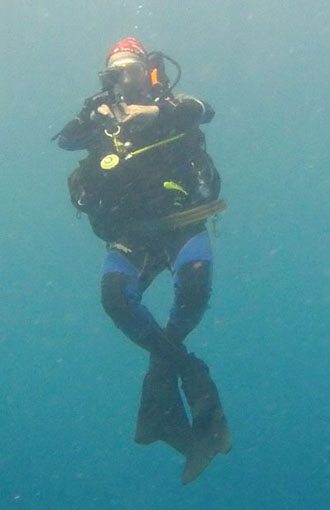
Enjoyed a walk around Playa one night, round the built up bar/restaurant/souvenir filled streets. Day 1 in Playa you think, WOW, all this silver, and I must have one of those decorated skulls covered in stones, mosaics, gaudy colours, and maybe a wooden face mask! My house will not be the same without one! Day 3 in Playa, who the hell is buying all these skulls, masks, the silver now looks tacky, going slightly mad around street after street of STUFF! And I have not seen anyone wearing a white, embroidered puff sleeved hippy/ethnic top since 1975! WHO IS BUYING THIS STUFF! One stall holder apparently shouted at Warren ‘come and have a look at my crap, same crap as everywhere else, just cheaper!’ Now I might have bought something off that guy, for amusement value at least.
Achieved another wish list goal, having my feet eaten in one of those foot fish spa’s. Myself and Trine were the only two who wanted to do it. Was told ‘you can get aids from that’. Really? So I can die on this holiday from cave diving, bull sharks, and now aids spreading fish. Spoilt for choice. So now I’m on an aids catching night out! Interestingly the fish spa host said, ‘if you start bleeding, don’t take your feet out, leave them in there’. Why? So the fish get the first decent meal they have had in days? So you don’t kill all the fish by dragging them out of the water as they attach themselves to you in a feeding frenzy? No bleeding, and we really enjoyed it. We think we got an extra 5 mins because Phil distracted the spa guy by running around the souvenir shop it was set in, and playing the didgeree-doo for the passers-by. Most experiences with Phil tend to lean towards the surreal after a short period of time. Mean streak though. Kept sloping off to McDonalds for his double-whatever burger, as it was the only place in town he could find with whole chillies to eat. Brought a few back, happily chewing one, offered them to me, expected a manageable jalapeño. THE PAIN. I could have punched him. However I couldn’t see him through the tears.
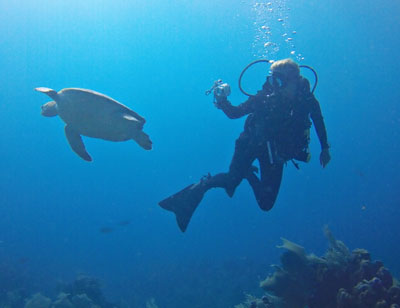 Our last dive was a ‘turtle dive’ out of Akumal, just down the coast. Well worth the trip as a complete contrast to Cozumel, Playa and the Ceynotes. Beautiful golden beaches, nice open fronted bar on the beach, and bizarrely, absolutely mobbed by hordes of people in flotation jackets and snorkels, going off in groups of ten or more, each with a guide, to be taken around an area just offshore to see turtles and rays. Not us, we are going off in a tiny boat, past the breaking waves to where the real action is!
Our last dive was a ‘turtle dive’ out of Akumal, just down the coast. Well worth the trip as a complete contrast to Cozumel, Playa and the Ceynotes. Beautiful golden beaches, nice open fronted bar on the beach, and bizarrely, absolutely mobbed by hordes of people in flotation jackets and snorkels, going off in groups of ten or more, each with a guide, to be taken around an area just offshore to see turtles and rays. Not us, we are going off in a tiny boat, past the breaking waves to where the real action is!
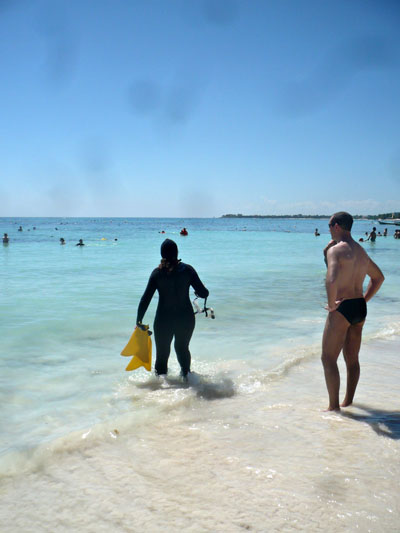 One, small, not so activity oriented turtle! Lovely reefs though. The shore diving members of our party were besieged by turtles ... fighting them off! Everyone went home the next day. Dawn, her husband Warren and I stayed on for an extra week to enjoy a tour about. So, first goal, straight back to Akumal, abandoned heat-loathing, non-diving water-hater Warren on the beach, shouting SEE YA, as we ran back into the sea, no guide or bright jacket, to find our own turtles. Few meters off the beach, huge turtle covered with remoras. Turtles, rays in abundance, all unbothered by our presence, despite the hordes of people there. Lovely couple of hours.
One, small, not so activity oriented turtle! Lovely reefs though. The shore diving members of our party were besieged by turtles ... fighting them off! Everyone went home the next day. Dawn, her husband Warren and I stayed on for an extra week to enjoy a tour about. So, first goal, straight back to Akumal, abandoned heat-loathing, non-diving water-hater Warren on the beach, shouting SEE YA, as we ran back into the sea, no guide or bright jacket, to find our own turtles. Few meters off the beach, huge turtle covered with remoras. Turtles, rays in abundance, all unbothered by our presence, despite the hordes of people there. Lovely couple of hours.
The rest of the week was interesting. Warren and Dawn went in one direction for their exploration, me in the other. Few historic Mayan sites, flamingos at Rio Lagartos, and a small old colonial town called Valladolid. Hidden charms, very VERY hidden! But after 3 days into my use of Valladolid as a base, the charm seeped in. It may be linked to the discovery of a lovely restaurant by an old monastery, which served the most amazing chocolate cocktails. Next to my table, the unrivalled attraction of a small cenote opening, from which small bats flew continually. Fantastic.
Mexican magic - Part 1 Cozumel Classics from David Purvis on Vimeo.
Mexican magic - Part 2 Perfect Playa pleasures from David Purvis on Vimeo.
Normandy 70 - Wreck Week Expedition Diary
- Details
- Category: Trip Reports
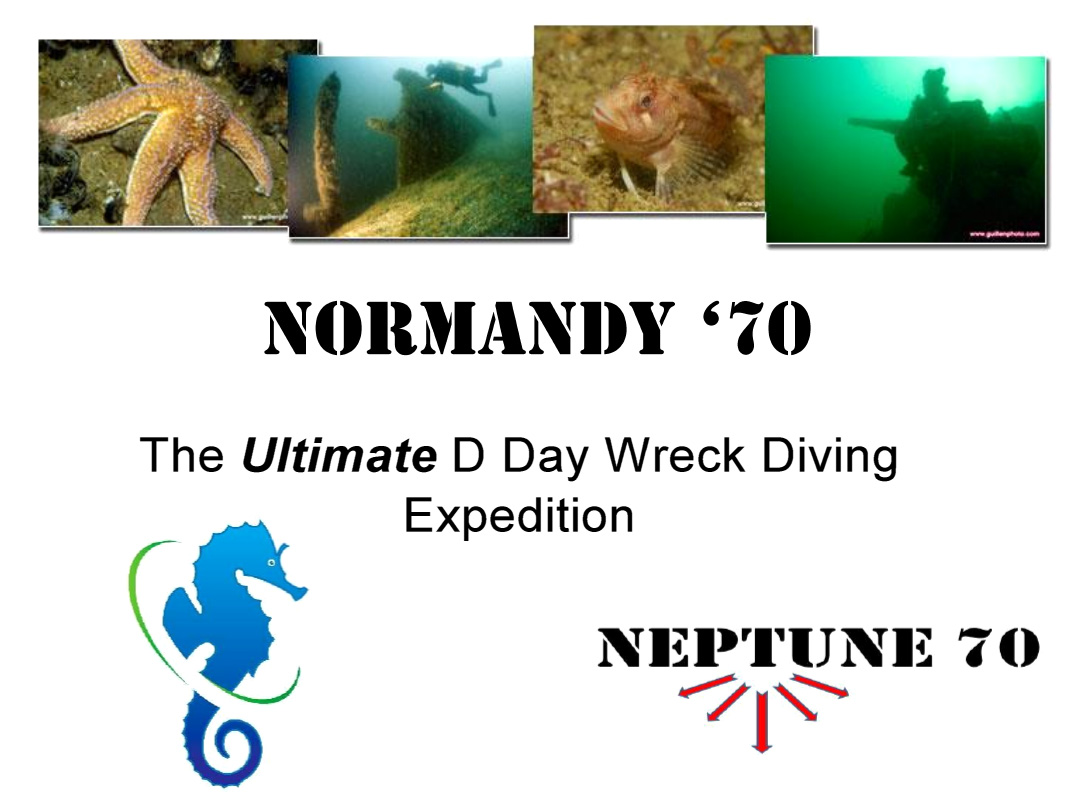
The Normandy 70 Wreck Week took place between 13-21 September 2014. Normandy 70 was an expedition by Southsea Sub-Aqua Club to dive and record wrecks associated with the maritime phase of WW2 Allied invasion of Normandy otherwise known as Operation NEPTUNE. This expedition was inspired by a BSAC Southern Region initiative (NEPTUNE 70) which seeks to encourage branches to investigate and dive wrecks associated with Operation Neptune in British waters.
Expedition Members recorded a daily account of the diving and other activity during the Expedition, and this informal daily diary with pictures, information on the wrecks, diving and other activity can be viewed by clicking the links below: (Owing to the number of pictures, these files may take a few seconds to load in a new window)
Normandy 70 - Expedition Plan
- Details
- Category: Normandy 70
This expedition was to utilise both divers from Southsea Sub-Aqua Club and Scuba Ninjas, who are based in France and have divers from France, Ireland, Africa, Spain and the UK. As a consequence, there would be some additional planning required to ensure that everyone is involved, suitable procedures are in place for diving on sites where lives were lost and much more.
Click the title page to see the whole plan
Mulberry 70 - Project Summary
- Details
- Category: Mulberry 70
Project Aim:
A project to commemorate the role of the Mulberry Harbours and the 70th anniversary of the WW2 invasion of Normandy through the recording of elements of Mulberry Harbour in waters around Hampshire, the Isle of Wight and West Sussex.
Location of sites; 20+ sites primarily in the Solent / Selsey area.
Project Programme –
Jan to Jun 14; Detailed planning, training, historical research and site identification
16 to 26 Aug 14 Diving , ROV and Side-scan surveys.
Sept – Dec 14 Final project report and outreach.
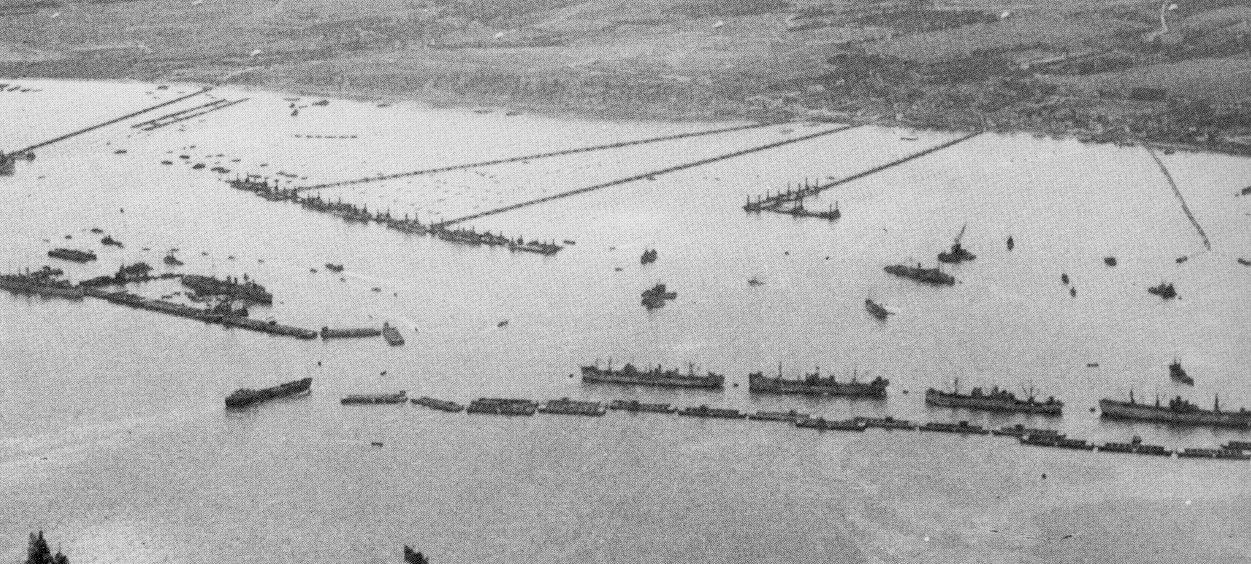
Subcategories
Local Diving Information
![]()
Over the years our club has used a variety of local facilities to help us go diving. There are also a variety of different dive sites available to meet the needs of divers with a wide range of experience and interests.
- Boat Charters
- Launch sites
- Dive Shops (Gas & Gear)
- Inland diving
- Shore Dives
- Boat Dives
- Charts, tides & weather
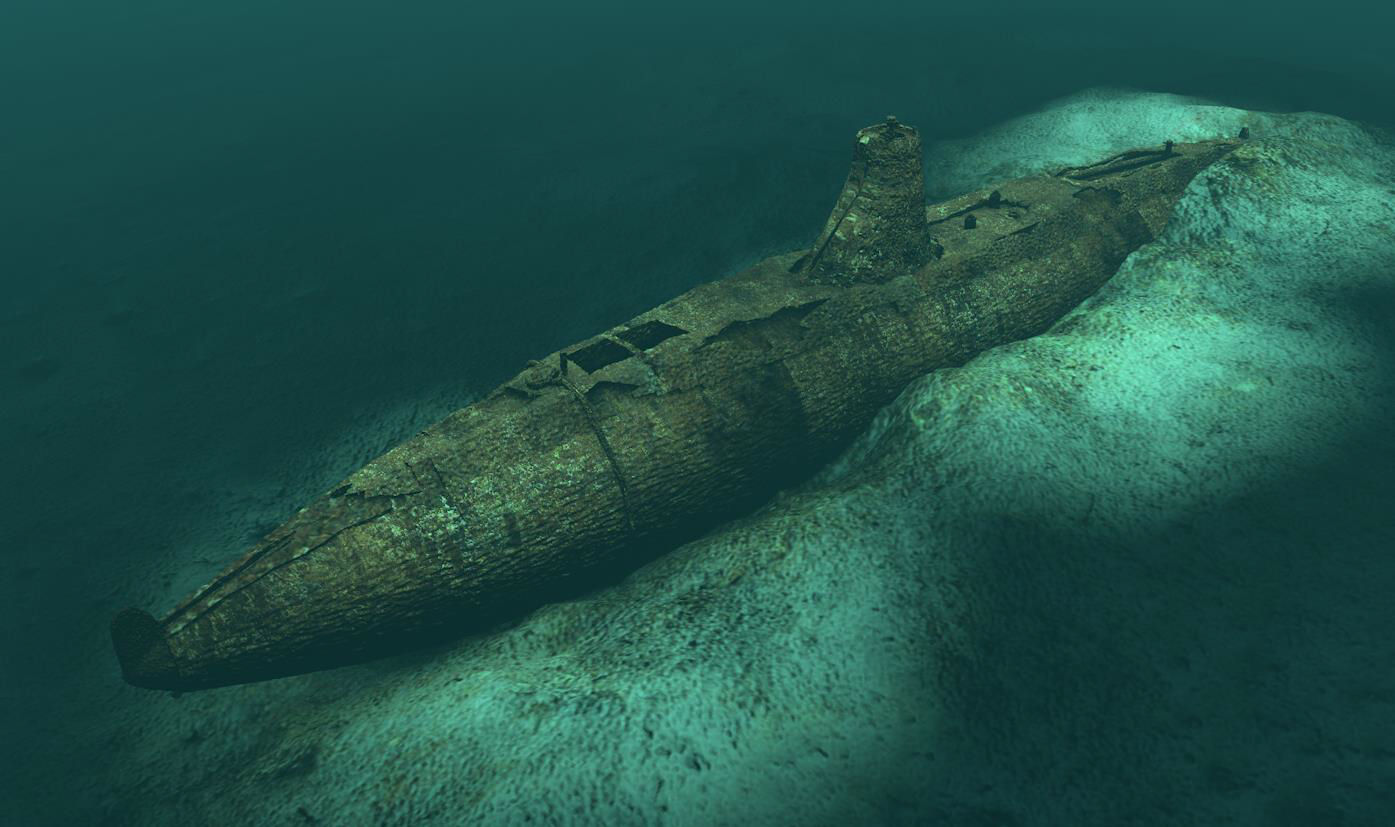
We are lucky to be located in the middle of the south coast. The local area offers the possibility of a range of diving from shallow easy dives for a trainee diver, to deeper, more challenging dives for the experienced mixed gas diver. The sites are often based around a wreck, with a few gullies or reefs too. The wrecks include a wide range of crafts. They are not limited to just shipwrecks from both wars, even if these are the more common. We have a range of historic sites including the Mulberry Harbours, Tanks & Bulldozers, aircraft, and submarines. There are a few protected sites too, such as the HMS A1, HMS Invincible & Thorness Bay protected wrecks which are diveable with the permission of the respective Licensees.
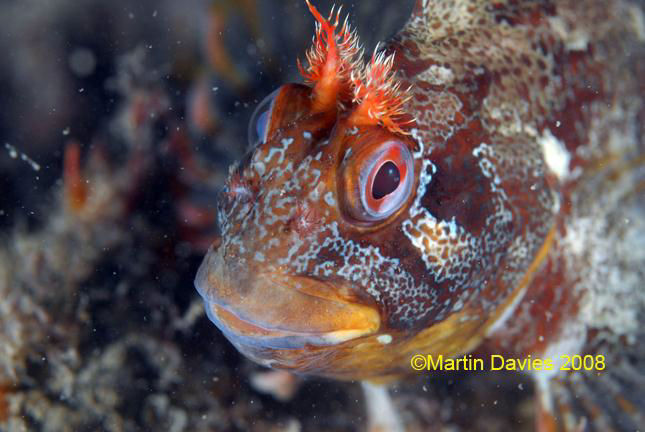
Sealife varies from season to season. It includes things such as sponges, pink fan coral, Pollack, blennies, pipefish, common starfish, painted top shells, whelks, mussels, oysters, scallops, cuttlefish, dogfish, wrasse, a variety of crabs, lobsters, eels, rays and many flatfish. If you are lucky, then you may be accompanied by a pod of dolphins on your way to the dive site!
Picking the right conditions can be tricky. The Solent Ooze covers some areas and can contribute to the debris floating in the water column. It isn’t helpful when the dredgers are busy improving the local harbours which would otherwise silt up. There are a couple of dumping grounds, the most popular being just south of the Nab Tower to the east of the shipping channel on the east side of the Isle of Wight.
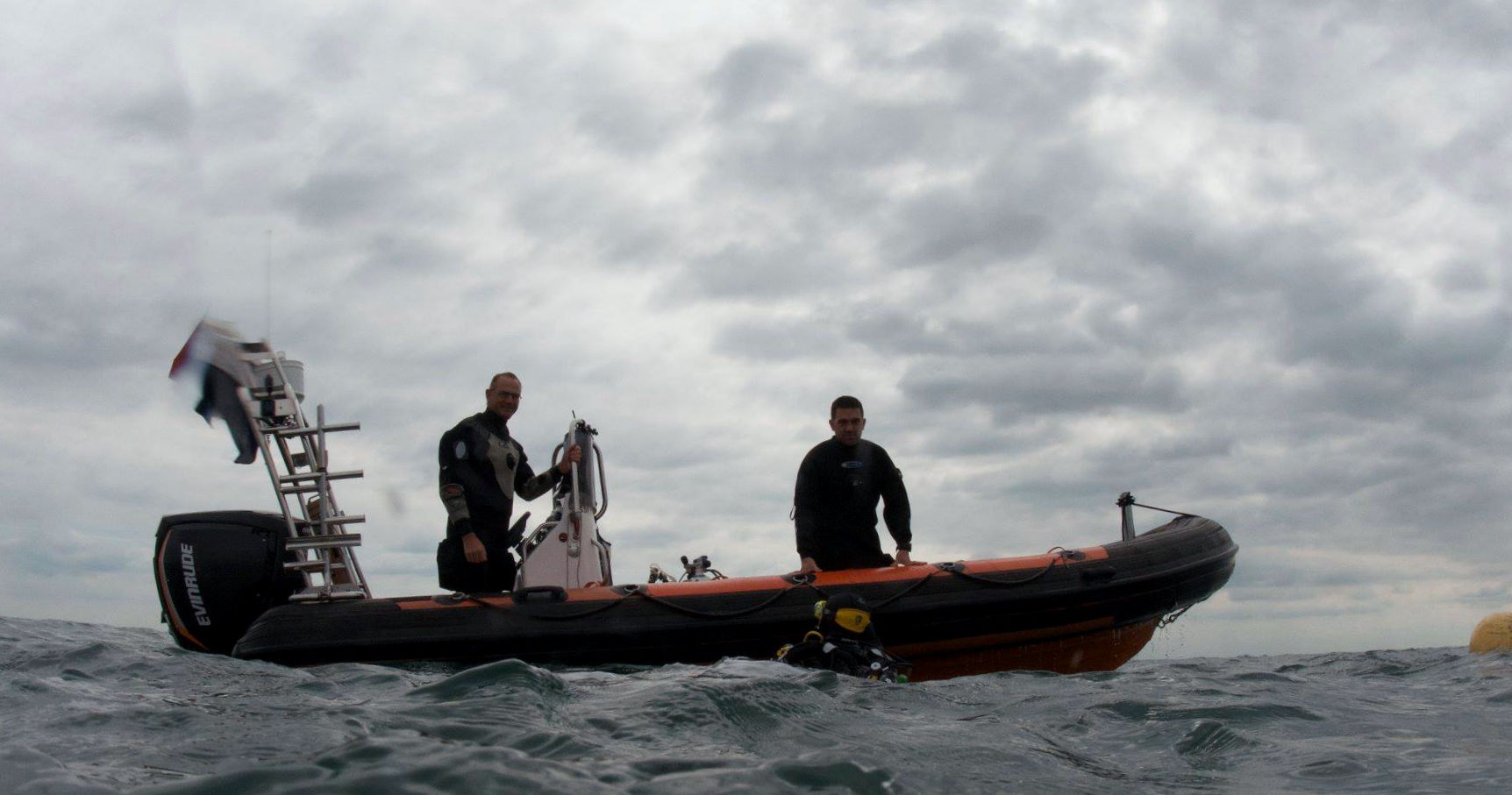
The local tidal forces are unique. The Isle of Wight has an effect and when the conditions are right, you can get a double high tide. This can make planning slack water “interesting” at times. Some areas are better dived at low water slack, whilst a few are better dived at high water slack. There are a handful of drift dives, but most diving is best completed on slack water.
Guides such as “Dive Isle of Wight and Hampshire” or “Dive Sussex” are useful for identifying many of the local dive sites. They haven’t been updated for a few years and there are several errors in many of the listed sites as a result of time and more up to date information becoming available. For more accurate GPS marks, it can be better to use the website https://www.wrecksite.eu/ .
![]() Return to the Local Diving info page...
Return to the Local Diving info page...
Trip Reports

Members of Southsea Sub-Aqua Club often plan a weekend, long weekend, week or longer trips together to a variety of places either in the UK or abroad. Sometimes a member of the group will put together a diary or report and illustrate it with some images of the holiday. Often too they'll include a little humour as well. Below are some diaries and reports of what they got up to on a few of the trips. Many are holidays and a few are about the expeditions or projects which members have been involved with too.
Diving Projects
Britain has relied upon the seas surrounding her for many millennia. Whether it has been for fishing, the import and export of goods, travelling and exploration or for protecting her shores from potential invaders. Occasionally a craft has failed to complete its journey and has sunk below the waves, leaving a wreck. More often this has been caused by a storm at sea, but can also have been caused by an accident (i.e. collision), navigational error or through warfare.
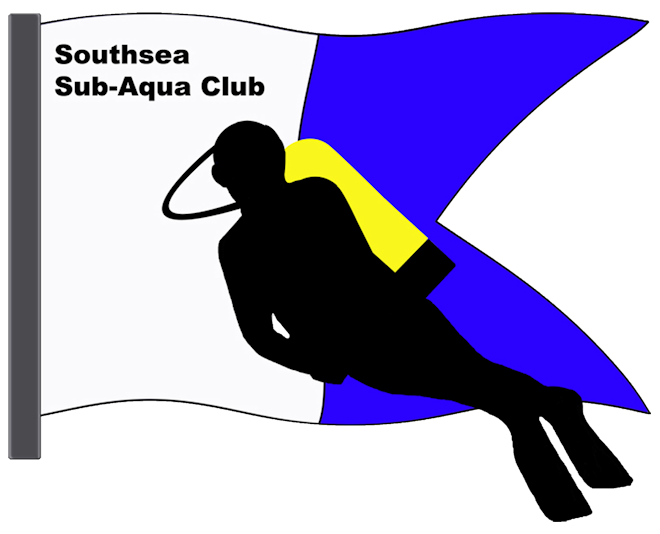
Southsea Sub-Aqua Club has a long history of wreck site investigation, the most well-known being "Project Solent Ships" which directly led to the discovery of the Mary Rose, but we didn't stop there. Over the years the Club has developed an association with a number of local wreck sites and some off the Normandy coast.
The projects involve a number of different types and ages of wrecks. They include ships, landing craft, aeroplanes, Mulberry harbours, armoured bulldozers and tanks from the two World Wars, as well as older wrecks, much older.
Today there are various courses available to help divers to record the sites and various members have completed such courses. They may have been completed within the club or through other organisations, such as the Nautical Archeology Society (NAS) or a University.
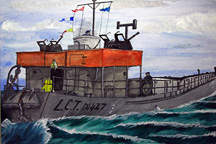
Some techniques have changed over the years as new technologies have become available. Where once an accurate sketch may have been sufficient, today you'll often find people still using tape measures and underwater slates, but also you'll find some using underwater cameras to help produce stills, video and 3D images. Often local and national news services have become interested in the stories of the projects too.
The articles below provide links to the various projects. They include photos and drawings of the sites, a record of the kind of life observed by the teams as well as some history to help bring them back to life.



